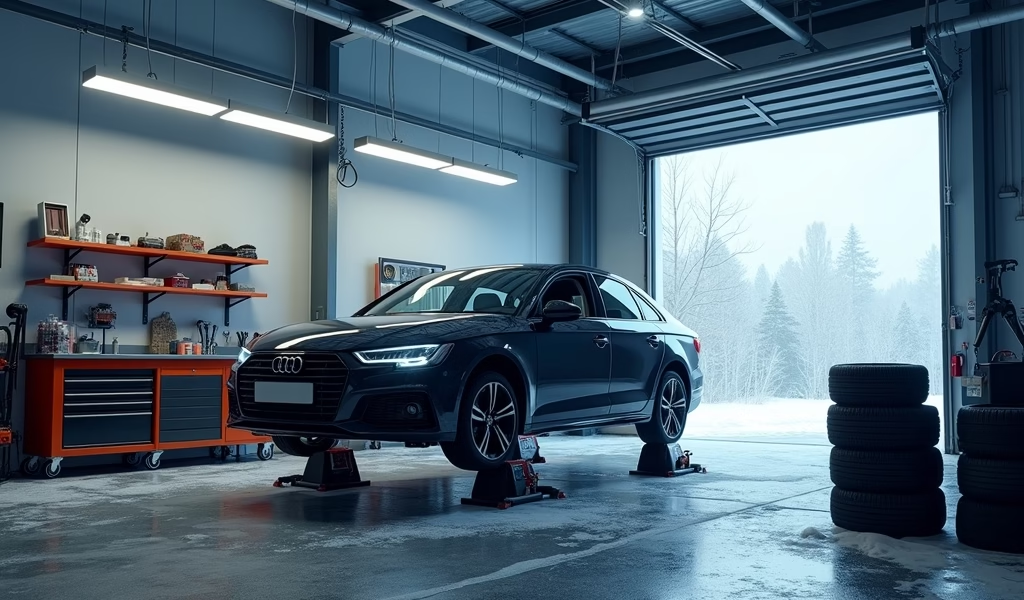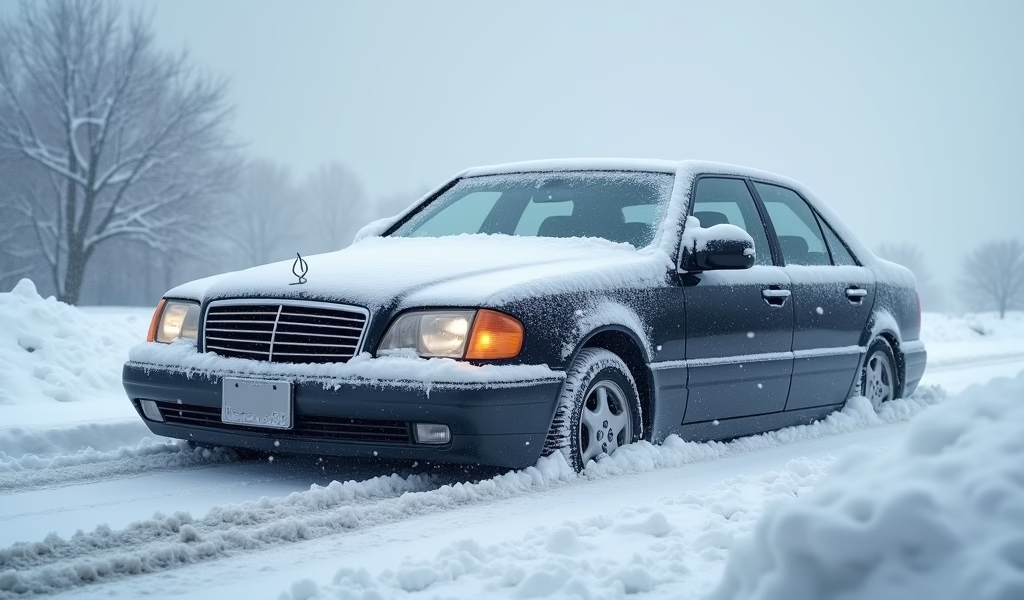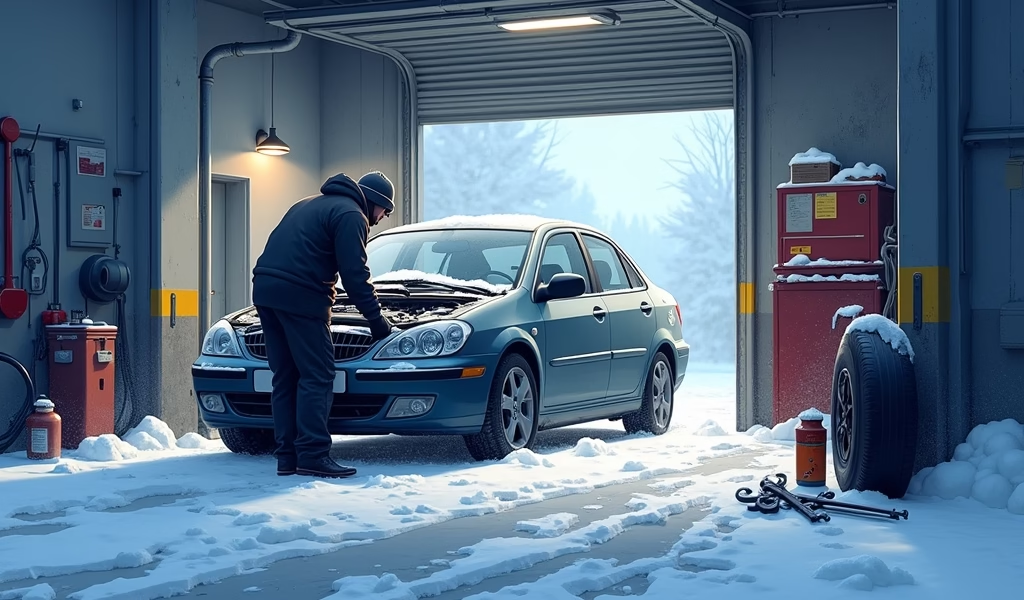Overview
This winter car maintenance guide covers ten essential areas including battery care, tire maintenance, fluid checks, visibility systems, emergency preparation, exhaust and heating system inspections, exterior protection, and professional preventative maintenance. Proper winter vehicle maintenance not only prevents breakdowns in freezing temperatures but significantly improves safety by addressing common issues that contribute to over 116,800 injuries and 1,300 deaths annually on American roads during winter conditions.
Table of Contents
- Understanding Winter Car Maintenance
- Battery Care: Preventing Cold-Weather Failures
- Tire Maintenance: Your Winter Safety Foundation
- Fluid Checks: Beyond the Obvious
- Visibility Matters: Wipers and Lights
- Emergency Prep: Better Safe Than Sorry
- Exhaust System Inspection: A Critical Safety Check
- Heating System: Comfort and Safety Combined
- Exterior Protection: Preserving Your Investment
- Preventative Maintenance: The Professional Advantage
- Conclusion: Winter-Ready, Worry-Free
- Frequently Asked Questions
Understanding Winter Car Maintenance
Winter brings unique challenges to vehicle performance and safety. As temperatures plummet, your car faces stress that can transform minor issues into major headaches. After 25 years working as an ASE-certified mechanic, I’ve seen countless preventable winter breakdowns that proper maintenance could have avoided.
Effective winter car maintenance isn’t just about keeping your vehicle running—it’s about keeping you safe. According to the National Highway Traffic Safety Administration, winter weather-related vehicle issues contribute to over 116,800 injuries and 1,300 deaths annually on American roads. Most of these incidents could be prevented with simple precautionary measures.
The good news? You don’t need to be a mechanic to prepare your vehicle for winter. This guide walks you through ten proven fixes that will substantially improve your car’s winter performance and reliability. Let’s transform winter driving from a white-knuckle experience into a comfortable, confident journey.
Battery Care: Preventing Cold-Weather Failures
Your battery works harder in winter, and for good reason. Studies from the Car Care Council show that at 0°F, a battery loses about 60% of its strength, yet the engine requires nearly twice the power to start. This perfect storm explains why battery failures spike when temperatures drop.
First, check your battery’s age. Most batteries last 3-5 years, but in extreme climates, this can be shorter. If yours is approaching the 4-year mark, consider a proactive replacement before the first freeze.
Next, inspect the terminals for corrosion—that white, powdery substance that accumulates on connections. This creates resistance, making it harder for power to flow when you need it most. Clean terminals with a mixture of baking soda and water, using an old toothbrush for stubborn deposits. After cleaning, apply a thin coat of petroleum jelly to prevent future corrosion.
For those with access to basic tools, test your battery’s voltage. A healthy battery should read around 12.6 volts when the engine is off. During cold starts, watch your headlights—if they dim significantly when starting, your battery may be weak.
If you’re not comfortable with DIY battery maintenance, most auto parts stores offer free battery testing. This five-minute check could save you from being stranded in freezing temperatures.

Tire Maintenance: Your Winter Safety Foundation
Your tires provide the only contact between your vehicle and the road, making them arguably your most important winter safety feature. According to research from Transport Canada, proper tire inflation alone can improve traction by up to 30% in winter conditions.
First, check your tire pressure weekly during winter. For every 10°F drop in temperature, tires lose about 1 PSI of pressure. Underinflated tires reduce traction and increase stopping distances—a dangerous combination on icy roads. Your vehicle’s recommended tire pressure is listed on the driver’s door jamb or in your owner’s manual.
Next, assess your tread depth. The legal minimum is 2/32″, but for winter driving, experts recommend at least 6/32″. The classic penny test works well: insert a penny with Lincoln’s head upside down into your tire tread. If you can see all of Lincoln’s head, your treads are dangerously worn.
Consider dedicated winter tires if you regularly face snow and ice. These specialized tires use rubber compounds that stay flexible in cold temperatures and feature tread patterns specifically designed to grip snow. Consumer Reports testing shows winter tires can reduce braking distances on ice by nearly 30% compared to all-season tires.
Don’t forget to check your spare tire as well—it’s the one tire you hope never to use, but in winter, it could be your lifesaver. Ensure it’s properly inflated and in good condition before the season starts.
Finally, consider carrying tire chains if you’ll be traveling through mountain passes or areas where they might be required. Practice installing them before you need them—a parking lot rehearsal beats learning during a snowstorm.
Fluid Checks: Beyond the Obvious
Winter car care extends well beyond antifreeze, though that’s certainly where we’ll start. Your cooling system protects your engine from extreme temperature variations, and the right antifreeze mixture is critical. Most vehicles require a 50/50 mix of antifreeze and water, which prevents freezing down to about -34°F while also preventing boiling in summer.
Testing your antifreeze is simple with an inexpensive tester from any auto parts store. If your antifreeze is over five years old or doesn’t provide adequate protection, flush and refill your system. While doing so, inspect all radiator hoses for cracks or softness—cold temperatures make already-weakened hoses prone to sudden failure.
Next, check your oil. As temperatures drop, oil thickens. If you’re due for an oil change before winter, consider switching to a lower viscosity oil as recommended in your owner’s manual for winter driving. Synthetic oils generally perform better in extreme temperatures, flowing more easily during cold starts when your engine is most vulnerable.
Don’t overlook brake fluid, which can absorb moisture over time. This moisture can freeze in brake lines, causing serious safety issues. If your brake fluid hasn’t been changed in the past two years, consider a flush before winter arrives.
Windshield washer fluid is another winter essential—but not all formulations are equal. Summer washer fluids may freeze at temperatures as high as 32°F, rendering them useless when you need them most. Replace with winter-specific fluid rated to at least -20°F, and keep your reservoir full throughout the season.
Finally, check your power steering and transmission fluids for proper levels and condition. Cold weather can exacerbate small leaks, and these systems are expensive to repair if neglected.
Visibility Matters: Wipers and Lights
When winter storms hit, visibility becomes your primary safety concern. Start with your wiper blades—these inexpensive rubber components deteriorate faster than most people realize. The American Automobile Association recommends replacing wiper blades every six months, yet studies show most drivers wait until they’re completely failing.
Winter-specific wiper blades feature a robust rubber shell that prevents ice and snow buildup. They cost slightly more than standard blades but provide dramatically better performance in winter conditions. When installing new blades, also fill your washer fluid reservoir with winter-grade fluid that won’t freeze on contact with your windshield.
Don’t forget your rear wiper if your vehicle has one—it’s often neglected but crucial for safe backing and lane changes during snowfall. While checking wipers, verify that your defrosters (front and rear) are working properly. These systems are your first line of defense against fogging and ice accumulation.
Lighting becomes even more critical during winter’s shorter days and reduced visibility. Check all exterior lights—headlights, taillights, brake lights, turn signals, and hazard lights. Replace any bulbs that are dim or non-functional. Consider upgrading to higher-performance bulbs that provide better illumination without exceeding your vehicle’s specifications.
Clean your headlight lenses if they’ve become yellowed or cloudy. Oxidized headlights can reduce light output by up to 80%, according to testing by Consumer Reports. Headlight restoration kits are available for under $25 and can dramatically improve nighttime visibility.
Finally, keep a small spray bottle of deicer in your glove compartment. This can be invaluable for quickly clearing frozen wiper blades or thawing frozen locks without damaging components.

Emergency Prep: Better Safe Than Sorry
Even with perfect maintenance, winter conditions can lead to unexpected situations. Preparing an emergency kit is like buying insurance you hope never to use—but will be immensely grateful for if needed.
Start with the basics: a quality ice scraper with brush, small shovel, and bag of sand or cat litter for traction. Add jumper cables or, better yet, a portable jump starter that doesn’t require another vehicle. Modern lithium jump starters are compact and maintain their charge in cold temperatures.
Include a comprehensive emergency kit with blankets, extra gloves, hand warmers, and non-perishable snacks. A flashlight with fresh batteries, reflective triangles, and a first aid kit are essential for any roadside emergency. Consider adding a portable phone charger that doesn’t require your car’s power.
Keep your gas tank at least half full during winter. This prevents fuel line freezing and ensures you can run the engine periodically if stranded. It’s not just about avoiding running out of fuel—it’s a critical safety measure during extreme cold.
Program emergency roadside assistance numbers into your phone, and keep a physical copy in your glove compartment. Many insurance policies and new vehicles come with roadside assistance programs, but you need the correct number to access help.
Finally, consider sharing your travel plans when making longer winter journeys. Let someone know your route and expected arrival time, especially when traveling through remote areas. This simple step ensures someone will know to check on you if you don’t arrive as scheduled.
Exhaust System Inspection: A Critical Safety Check
Your vehicle’s exhaust system deserves special attention before winter. Beyond performance issues, exhaust problems can become life-threatening during winter when we drive with windows closed and heaters running.
Carbon monoxide poisoning causes approximately 430 deaths annually in the United States, according to the Centers for Disease Control, with some occurring in vehicles with faulty exhaust systems. This colorless, odorless gas can accumulate if exhaust components are compromised, particularly when snow blocks the tailpipe.
Check for rust, holes, or loose connections throughout the exhaust system. Pay particular attention to the area where the exhaust manifold connects to the engine block—heat cycles can loosen these connections over time. Listen for new or unusual exhaust sounds, especially a hissing noise near the engine or a rumbling under the vehicle, which may indicate leaks.
If your vehicle has been making more noise lately or you notice decreased fuel economy, have your exhaust system professionally inspected before winter. Modern catalytic converters are expensive components that can be damaged by small problems that go unaddressed.
Remember to clear snow away from your tailpipe before starting your car if it’s been parked during snowfall. Even properly functioning exhaust systems can channel carbon monoxide into the cabin if the tailpipe is blocked by snow.
Heating System: Comfort and Safety Combined
Your vehicle’s heating system isn’t just about comfort—it’s a critical safety feature that prevents windshield fogging and maintains driver alertness in cold conditions. Testing your heater before the first cold snap can prevent unpleasant surprises.
Start with a simple function test. Run your heater on high, checking for strong airflow and proper temperature. If airflow is weak or the air doesn’t get sufficiently warm, you may have issues ranging from a clogged cabin air filter to a failing heater core.
Your cabin air filter should be replaced annually or more frequently if you drive on dusty roads. A clogged filter restricts airflow, reducing heating effectiveness and potentially overworking the blower motor. Most cabin filters are accessible behind the glove compartment and can be replaced in minutes without special tools.
If your heater works but your windshield fogs persistently, check that your climate control system’s recirculation function is working properly. Using fresh outside air (not recirculated) typically reduces fogging, as outside winter air contains less moisture than the warm air inside your vehicle.
For vehicles equipped with heated seats or steering wheels, verify these features work before you need them. These systems can fail independently of the main heating system and significantly enhance winter driving comfort.
Don’t overlook your rear defroster. This simple grid of heating elements is essential for maintaining visibility through your rear window. Test it by turning it on and touching the inside of your rear window after a few minutes—you should feel warmth across the entire surface.
Exterior Protection: Preserving Your Investment
Winter’s combination of road salt, ice, and temperature fluctuations creates the perfect environment for accelerated corrosion. Protecting your vehicle’s exterior isn’t just about aesthetics—it’s about preventing costly structural damage.
Start with a thorough pre-winter wash and wax. A quality wax creates a hydrophobic barrier that helps prevent moisture and salt from contacting your paint. For maximum protection, consider a professional-grade synthetic sealant or ceramic coating, which can provide protection for months rather than weeks.
Protecting your car from snow and ice extends to the undercarriage, where most serious corrosion begins. Many car washes offer underbody spray services, which are particularly valuable during winter months. If you live in an area where road salt is heavily used, try to wash your vehicle at least twice monthly during winter, focusing on thorough undercarriage rinsing.
Pay special attention to wheel wells, where slush and salt accumulate. Using a pressure washer can help remove buildup from these hard-to-reach areas. After washing, ensure your vehicle has time to dry completely before parking it for extended periods, as trapped moisture accelerates corrosion.
Door, hood, and trunk seals benefit from silicone lubricant application before winter. This prevents freezing and tearing of these critical weather barriers. Similarly, a graphite lubricant in door locks prevents freezing and key breakage during icy conditions.
For those parking outdoors, consider a quality car cover designed for winter use. These specialized covers allow moisture to escape while keeping snow and ice off your vehicle. Remember to remove any accumulated snow promptly, as its weight can damage wipers and antennas.
Preventative Maintenance: The Professional Advantage
While many winter preparations can be handled by the average car owner, some checks are best left to professionals with specialized tools and expertise. A pre-winter professional inspection often catches issues before they leave you stranded in freezing temperatures.
Ask your mechanic to pressure-test your cooling system, check belts and hoses, and verify your thermostat is functioning correctly. Modern engines rely on precise temperature regulation for emissions control and fuel economy—a stuck thermostat can cause serious problems beyond just comfort.
Have your battery load-tested, especially if it’s more than three years old. Standard voltage checks don’t reveal a battery’s ability to deliver high current during cold starting. Professional load testing simulates the demands of winter starting and provides a more accurate prediction of battery performance.
Request a comprehensive brake inspection, including fluid condition testing. Braking effectiveness decreases on icy roads, making system integrity even more critical. Your mechanic should check pad thickness, rotor condition, and hydraulic components.
If your vehicle has four-wheel or all-wheel drive that you rarely use, have these systems checked before winter. Components that sit unused can develop seals that leak when the system is eventually engaged. A professional can verify proper function before you need these features.
Finally, consider scheduling oil changes and routine maintenance before the winter rush. Service centers become extremely busy after the first snowfall, and appointment availability decreases dramatically. Preventative scheduling ensures your vehicle receives attention before winter conditions arrive.
Conclusion: Winter-Ready, Worry-Free
Winter car maintenance isn’t about perfection—it’s about preparation and peace of mind. The ten areas we’ve covered create a comprehensive shield against winter’s harshest effects on your vehicle. By addressing battery health, tire condition, fluids, visibility systems, emergency preparedness, exhaust integrity, heating functionality, exterior protection, and preventative professional maintenance, you’ve built a robust defense against winter’s challenges.
Remember that consistent attention throughout the season trumps a single intensive preparation. Quick weekly checks of tire pressure, washer fluid levels, and wiper condition keep small issues from becoming major problems. Monthly inspections of battery connections and exterior cleanliness preserve both function and value.
Winter driving doesn’t have to be stressful. With your vehicle properly maintained, you can enjoy the season’s beauty from the comfort of a reliable, safe automobile. The investment of time and resources in winter preparation pays dividends in avoided repairs, enhanced safety, and confident driving—regardless of what Mother Nature brings.
Stay warm, drive safely, and enjoy the winter knowing you’ve given your vehicle the attention it deserves.
Frequently Asked Questions
How often should I check tire pressure in winter?
Check tire pressure weekly during winter months. Cold temperatures cause pressure drops of approximately 1 PSI for every 10°F decrease.
Do I really need winter tires if I have all-wheel drive?
Yes, winter tires significantly improve traction regardless of your drive system. All-wheel drive helps you accelerate but doesn’t improve stopping distance on ice.
What’s the most important fluid to check before winter?
Antifreeze should be your top priority, ensuring it provides protection to at least -34°F. Check using an inexpensive tester available at any auto parts store.
How can I prevent my car doors from freezing shut?
Apply silicone spray to door seals before winter arrives. For locks, a graphite lubricant prevents moisture accumulation and freezing.
Should I warm up my car before driving in winter?
Modern vehicles need only about 30 seconds of warm-up time before gentle driving. Excessive idling wastes fuel and increases engine wear.


Pingback: Car Maintenance Checklist: 7 Proven Tips - knowsyourcar.com